Robert’s Rules of Order for Meetings: A Guide + Tips
Learn how Robert's Rules of Order can help your team conduct more structured, productive, and democratic meetings.
We all know the importance of running effective meetings, but it can be overwhelming to find the perfect method. If the problem your meetings are currently facing is a lack of structure, efficiency, and participation, a proven solution like Robert’s Rules of Order can offer a standardized framework to conduct meetings with fairness and effectiveness.
- What is Robert’s Rules of Order?
- Order of agenda according to Robert’s Rules
- Meeting minutes example
- Robert’s Rules of Order for meetings: cheat sheet
- The bottom-line
What is Robert’s Rules of Order?
“Robert’s Rules of Order”, a time-tested manual for conducting business and public gatherings, was published in 1876 by Henry Martyn Robert, an American soldier, engineer, and author. The handbook’s main goal was to set out parliamentary procedures or rules that companies and organizations could use as a standardized meeting approach.
Following Robert’s Rules and its democratic approach has allowed organizations to run effective and orderly meetings while displaying maximum fairness to each member. Even though this process for conducting meetings is pretty old, it’s still relevant nowadays. Robert’s Rules presents a meeting framework in which every individual within the team has an equal voice in the conversation, which is measured by voting.
A crucial aspect of this is understanding the agenda order, which ensures meetings are effective and adhere to the principles of democracy and fairness. By mastering the agenda structure, your team can navigate through discussions and decision-making processes more efficiently, thereby maximizing the productivity of their meetings.

Your meeting problem, solved.
Fellow is the only all-in-one meeting management software for remote and hybrid teams. Have fewer, more effective meetings and 1-on-1s with AI, behavior-driving features, and seamless integrations.

Order of agenda according to Robert’s Rules
- Call to order
- Roll call
- Reading and approval of minutes
- Reports of officers
- Reports of committees
- Standard order of business
- Announcements
- Adjournment
1 Call to order
The call to order is the first section of your meeting under Robert’s Rules of Order. This is a fancy way of stating the beginning of a meeting. The Robert’s Rules meeting initiation is essentially where the senior leader of the team facilitating the session starts the meeting with the rest of the group. Typically, the facilitator has a scripted agenda to use as they open and set the purpose and objective of the meeting.
2 Roll call
Roll call is the procedure in which the list of attendees is called off, and attendance is marked, and it plays a significant role in meetings. Typically, the Board Liaison or Clerk is responsible for conducting the roll call. By incorporating Robert’s Rules attendance protocol, meetings can be organized and structured, ensuring an enhanced meeting experience for all parties involved.
3 Reading and approval of minutes
In this part of the meeting, the facilitator consults the previous meeting minutes or notes. It’s important that these notes are sent to your team in advance so they have time to review the content. The meeting facilitator should ask if anything has been left out, needs editing, or requires updating.
To obtain Robert’s Rules meeting minutes approval, you’ll need to make all necessary changes or corrections to the minutes. If there aren’t any further revisions, the minutes then stand approved in their corrected version, and the meeting can proceed.
4 Reports of officers
Next up is the Robert’s Rules officer reports and motions. Senior leadership, the executive team, or board chairs will present their reports, where they state their recommendations and make any motions.
Motions require at least one other person to agree, which is referred to as a “second” in Robert’s Rules. Either the motion passes or fails, deciding whether the recommendation proposed by the officer is adopted.
Reports from the leadership team tend to include items of high importance, so it’s a crucial step in keeping the team informed and ensuring effective decision-making.
5 Reports of committees
The same process for the reports of officers is followed here, except that the heads of committees, groups, or boards within the organization provide their updates and recommendations. These reports are known as the Robert’s Rules committee reports and play a crucial role in decision-making.
Unlike the officer reports, the reporting members of any group or committee with recommendations can move straight to the necessary motion. Since the committee presenting has more than one person, the motion does not require unanimous consent or a “second” in the meeting to support it.
The Robert’s Rules committee reports and motions are essential to decision-making as they provide updates, insights, and recommendations from specialized groups within the organization.
6 Standard order of business
Once all reports and motions have been presented, the facilitator moves on to the standard order of business, also known as the Robert’s Rules standard meeting order. This is when the meeting agenda items, listed in order of priority, are covered seriatim, serving as a framework for the meeting Typically, the agenda items are any progress updates, challenges, or developments on what was discussed in the previous meeting. As projects evolve, additional items may be added subsequently.
By following the standard order of business, all meeting members can come prepared, have an active voice, and effectively contribute to the discussion. This ensures the meeting can be conducted efficiently and productively to promote collaboration amongst your team.
With Fellow, it’s easy to create collaborative agendas that ensure everyone has the context and information to show up ready to contribute. With Fellow’s browser extensions, access your meeting agenda directly from your video call or calendar event with one click, and check them off as you go.

7 Announcements
After checking off all the agenda items, each member has the opportunity to make important announcements. Robert’s Rules business announcements in these meetings are a formal way of giving important updates to the rest of your team members. This allows your team to prepare themselves for any big changes or developments in the organization or effectively schedule new projects in the pipeline.
8 Adjournment
If there’s no further business to be presented to the board or to be discussed, the meeting is adjourned. This is the Robert’s Rules meeting formal wrap-up, where you tie up loose ends and take any questions or comments from your team members. If someone hasn’t been able to contribute yet, this step gives them a chance to effectively participate in the meeting. You can also discuss what’s to be expected at the next meeting and the best way that each team member can come prepared, understanding what’s required of them.
Meeting minutes example
Robert’s Rules of Order for meetings: cheat sheet
Robert’s Rules of Order uses some outdated terminology, which can be confusing, but we’ve just coined modern adaptations of these words. In this section, we’ll clear up some key terms:
1Session:
A session is just another word for a meeting. In the context of Robert’s Rules, this would include any meeting of a deliberative assembly with a predetermined purpose.
2Quorum:
A quorum is the minimum number of voting team members who need to attend a meeting where a decision is being made. In Robert’s Rules terminology, this would be the presence of a deliberative board, committee or group for a business decision to be legally transacted.
3Order of business:
The order of business consists of the agenda priorities or agenda items. Adopting the agenda with the contributions of your teammates allows you to keep your meeting on track in terms of time and topic so that you can be as efficient as possible.
4Motions:
Motions are when ideas are brought forward to the rest of your team, and these ideas are discussed and considered. Motions are the reason meetings take place. This is where as a team, you decide which ideas will be implemented. If there isn’t unanimous agreement, a new motion needs to be seconded, meaning at least two people need to find an idea important enough to commit time during the meeting to it’s discussion. According to an article by BoardEffect, you can follow these six comprehensive steps for each motion:
- Motion: A member rises or raises a hand to signal the chairperson.
- Second: Another member seconds the motion.
- Restate motion: The chairperson restates the motion.
- Debate: The members debate the motion.
- Vote: The chairperson restates the motion and then asks for affirmative and then negative votes.
- Announce the vote: The chairperson announces the result of the vote and any instructions.
The bottom-line
Implementing Robert’s Rules of Order can not only enhance meeting effectiveness but can also ensure everyone has an equal opportunity to participate in making decisions or motions that will affect their day-to-day. Think about what will best suit you and your team, whether that’s trying a formal, structured Robert’s Rule approach or adopting some key parts of its principles that will fit with your team’s culture.
Fellow has you completely covered when it comes to enhancing the productivity and efficiency of your meetings. With the meeting agenda action items feature, you can easily create and track action items from your meeting agendas, making it easy to assign and track progress on these tasks.
With Fellow’s AI Meeting Copilot, you can take meeting minutes off the facilitator’s hands, as it automatically records, transcribes, and summarizes your meetings, ensuring that no detail goes forgotten. With AI-powered note-taking capabilities, you can access key insights, decisions, and action points long after the meeting has ended.
Furthermore, Fellow offers a wide selection of customizable meeting templates to assist you in preparing for these types of meetings. Whether you need a template for a staff meeting, a project update, or a problem-solving session, Fellow has you covered.
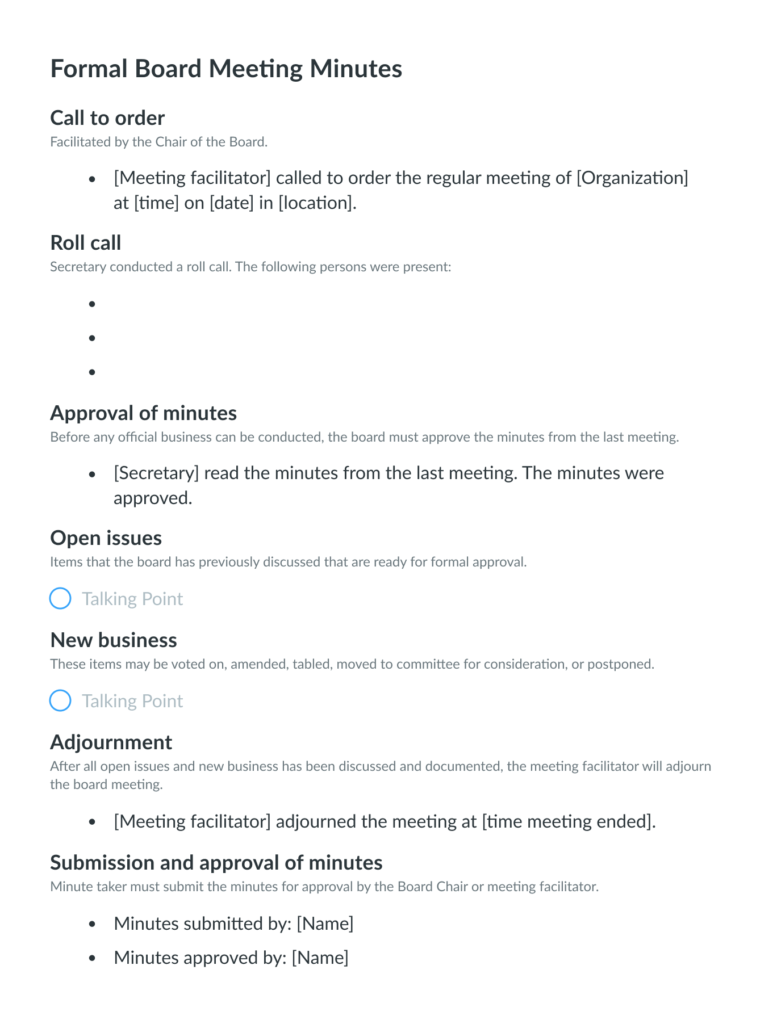






![How to Run a Delightful AGM [+ Free Template]](https://fellow.app/wp-content/uploads/2022/07/How-to-Run-a-Delightful-AGM-2.jpg)
![How to Successfully Run a Team Update Meeting [+ Examples]](https://fellow.app/wp-content/uploads/2022/06/How-to-Run-a-Team-Updates.jpg)

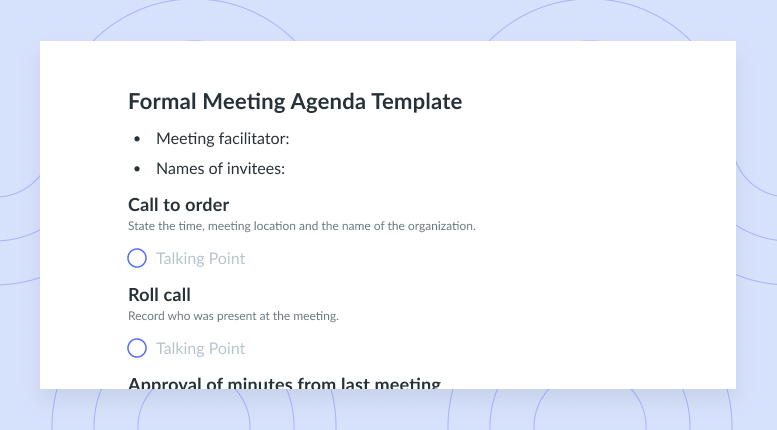
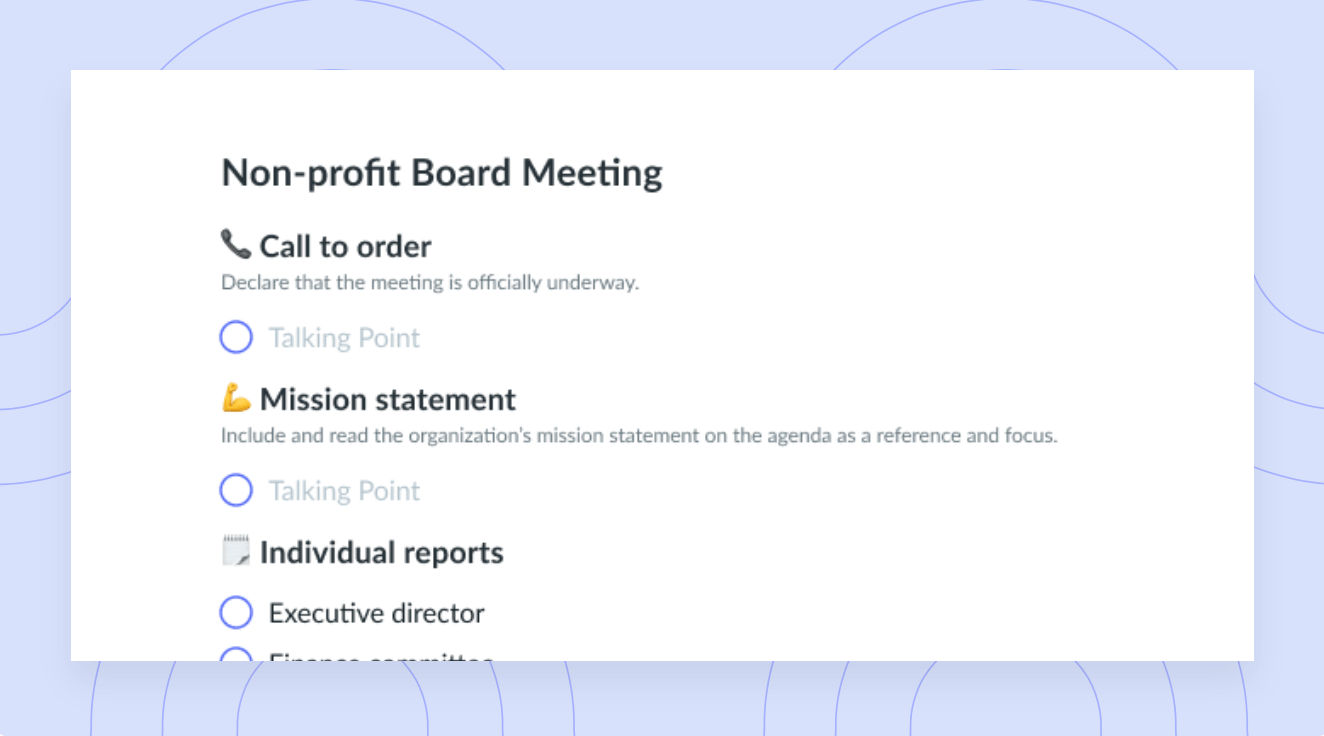
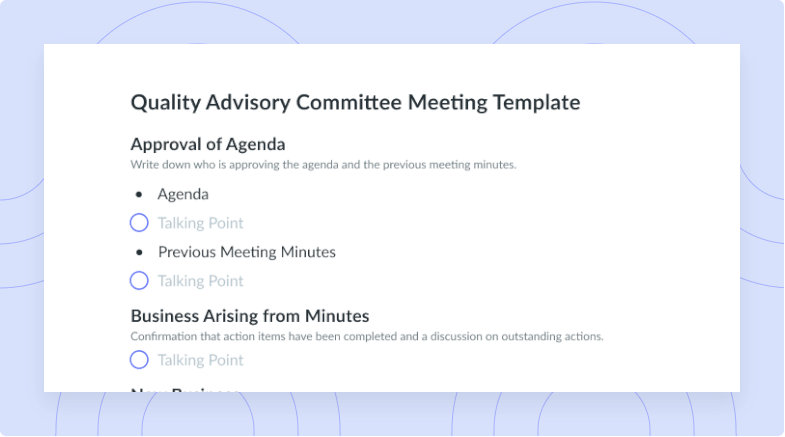
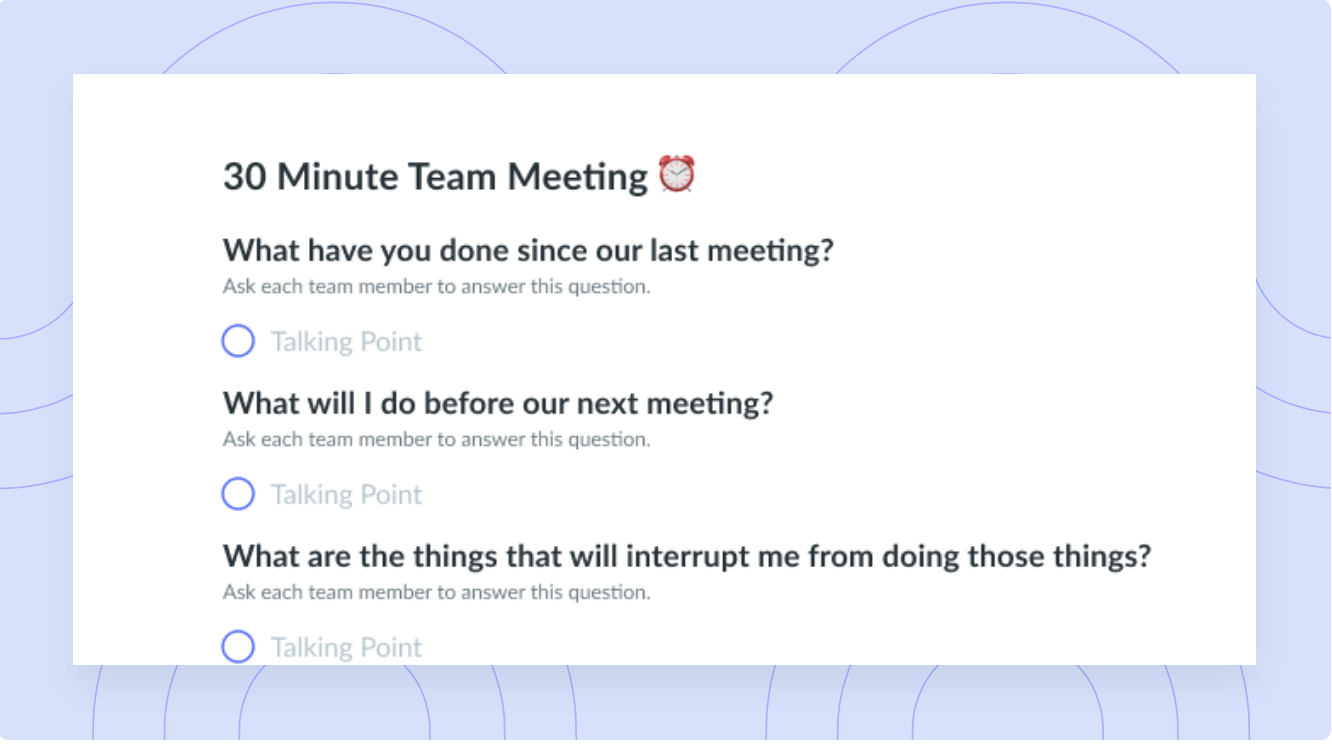


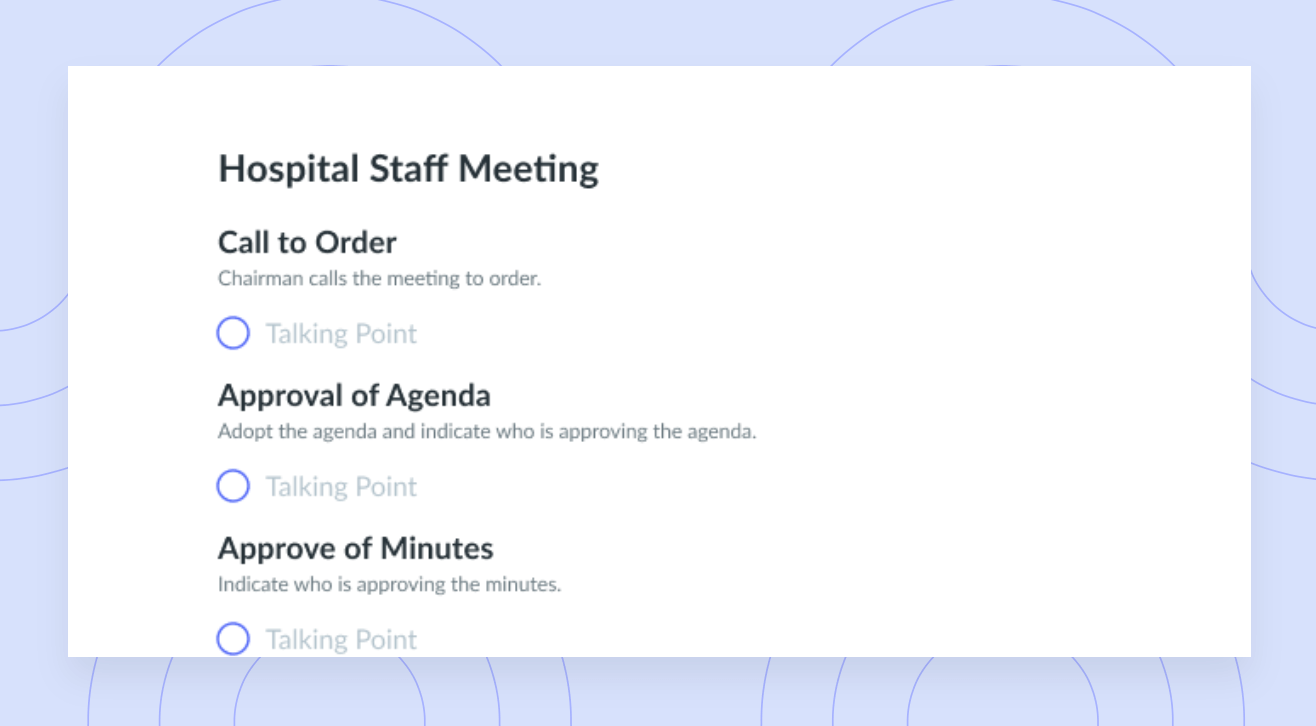
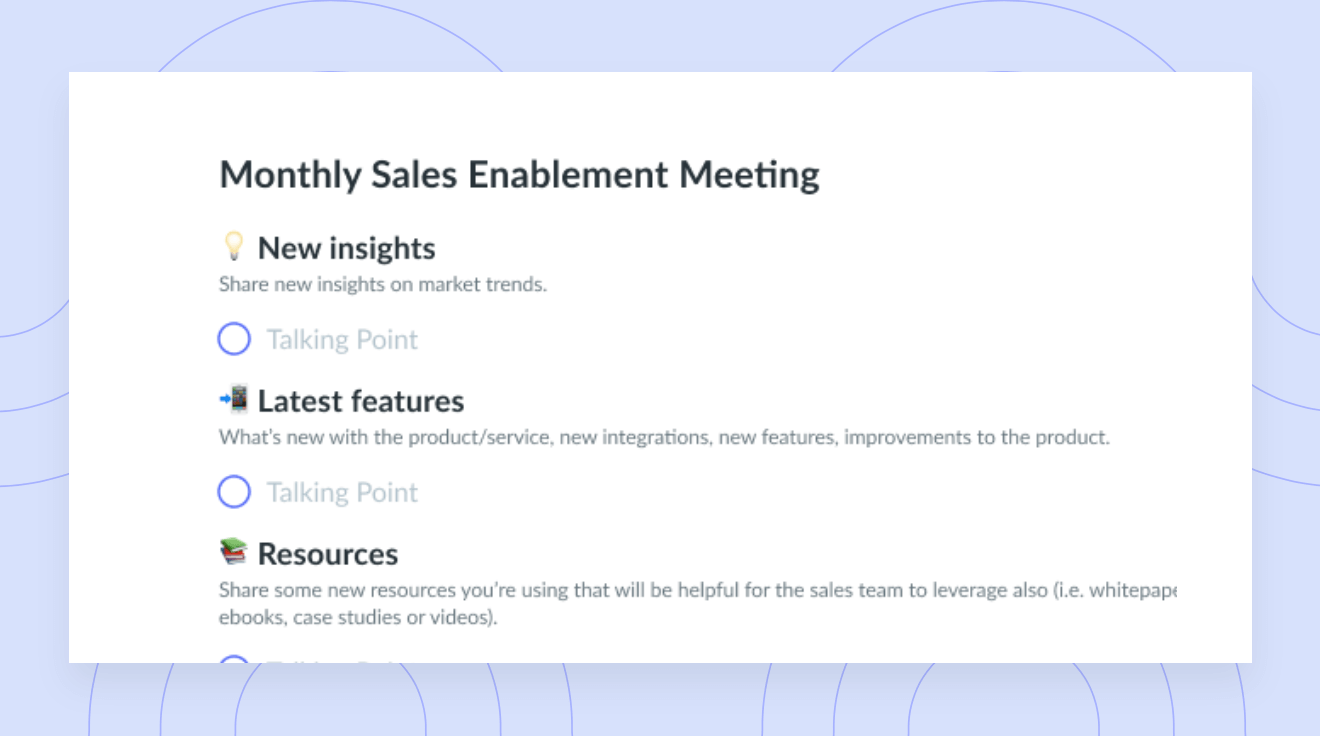
![COVID Update Meeting [Government Department] Template](https://fellow.app/wp-content/uploads/2021/09/COVID-Update-Meeting-Government-Department-preview.png)










